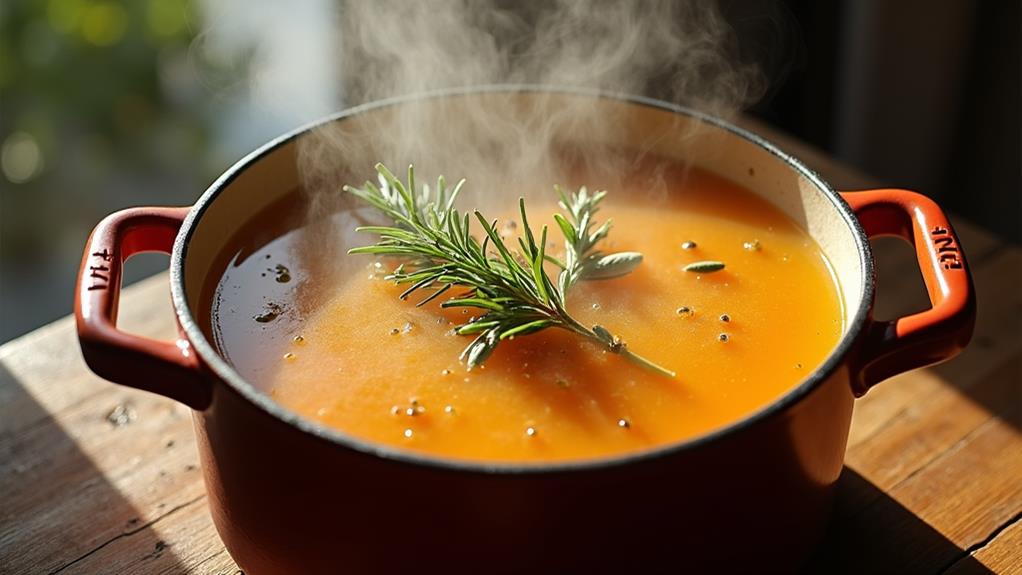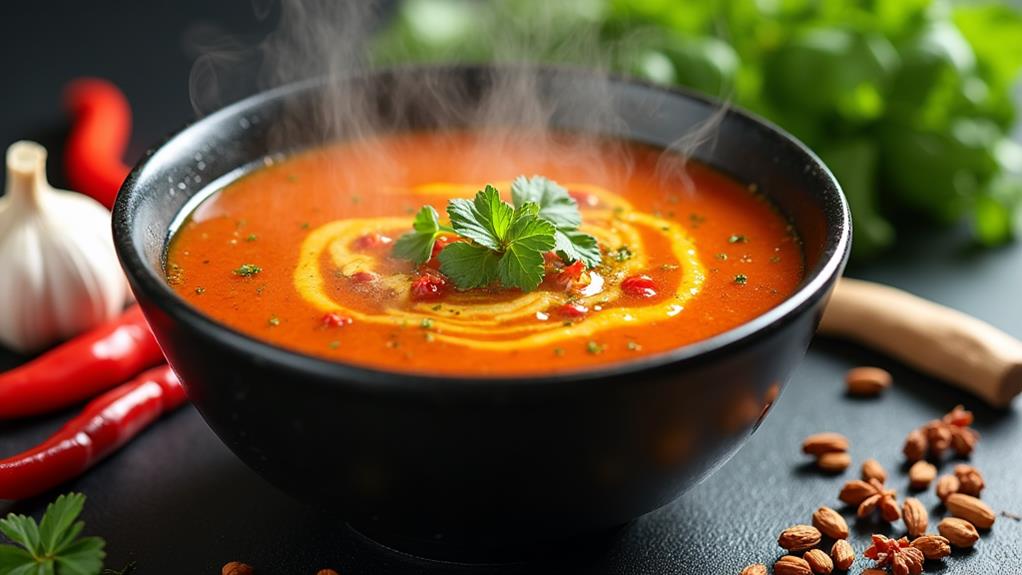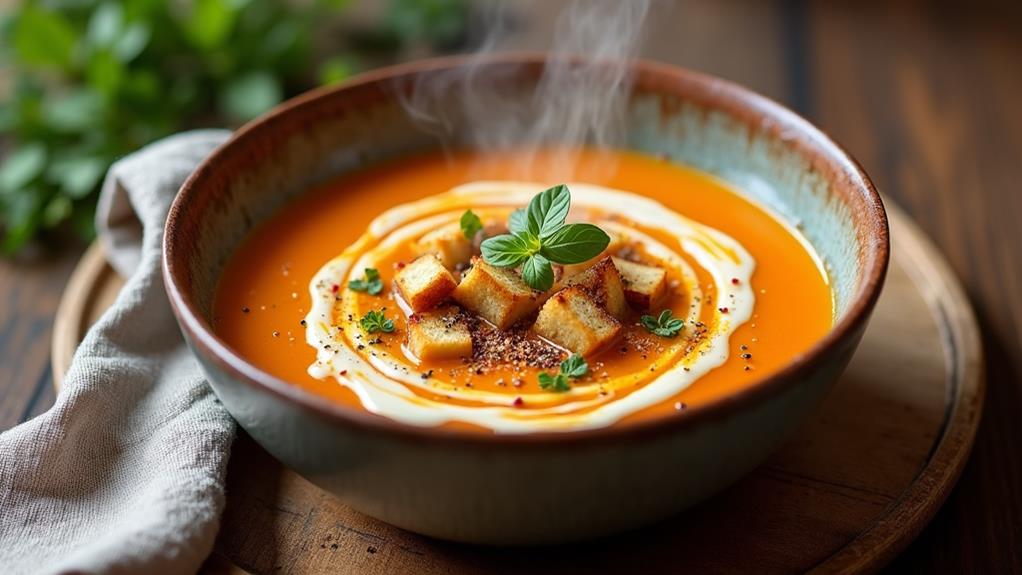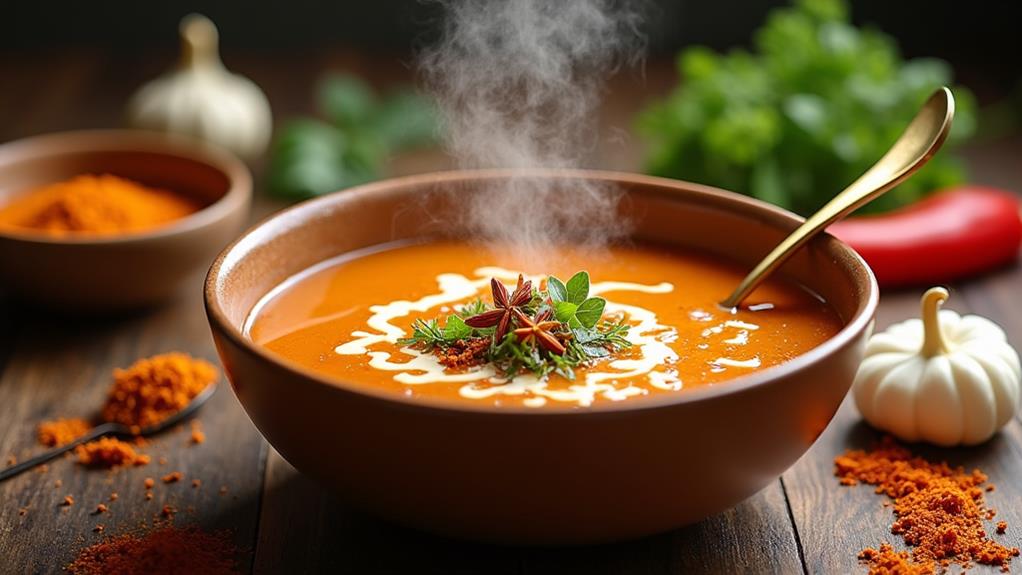To elevate your soup flavors, start by building a robust aromatic base with sautéed onions, garlic, and celery. Next, simmer with fresh herbs like rosemary and thyme for depth, and steep dry spices to unlock their full potential. Create oil-based infusions with ingredients like chili or lemon zest for added complexity. Unlock umami depth by incorporating slow-roasted vegetables or fermented ingredients such as miso. Finally, balance flavors with acidity from citrus or vinegar, and add finishing touches like a drizzle of herb oil or crispy garnishes. These techniques will transform your soups from ordinary to extraordinary, with each spoonful revealing layers of tantalizing flavors.
Flavor Infusion Fundamentals
Flavor Infusion Fundamentals
Three key principles underpin flavor infusion in soups. First, time is your ally. Allow ingredients to simmer and meld, creating a rich, cohesive broth similar to the one found in Harvest Vegetable Soup, which highlights seasonal vegetables like squash and carrots.
Second, temperature control is crucial. Maintain a gentle simmer to coax out flavors without compromising texture.
Third, balance is essential. Aim for a harmonious blend of savory, sweet, sour, and umami notes.
To master flavor layering techniques, start with a solid base of aromatics like onions, garlic, and celery. Build upon this foundation by adding layers of complementary ingredients, each contributing unique flavor profiles.
Consider ingredient pairing principles to create unexpected yet delightful combinations. For example, pair earthy mushrooms with bright citrus or smoky paprika with creamy coconut milk.
Don't shy away from experimenting with unconventional ingredients. Try infusing herbs like lemongrass or kaffir lime leaves for an exotic twist.
Incorporate umami-rich elements such as miso paste or fish sauce to add depth.
Building an Aromatic Base
To build a flavorful aromatic base for your soup, you'll want to start by sautéing foundational vegetables like onions, carrots, and celery.
Next, you can enhance the depth of flavor by toasting herbs and spices in the pan, releasing their essential oils and intensifying their aromas.
For an extra layer of complexity, consider infusing oils with aromatics like garlic or ginger before adding them to your soup base, allowing their flavors to permeate the entire dish.
Sautéing Foundational Vegetables
Almost every great soup starts with sautéing foundational vegetables to build a flavorful aromatic base. This crucial step lays the groundwork for a soup's depth and complexity.
You'll want to begin with a combination of aromatic vegetables, often referred to as mirepoix in French cuisine. Typically, this includes onions, carrots, and celery, but don't be afraid to experiment with other vegetables to create unique flavor profiles, such as understanding how spices like curry powder can enhance the flavor profile of your soup.
To elevate your soup's taste, follow these key steps:
- Start with caramelized onions, cooking them slowly until they're golden brown and sweet.
- Add sautéed garlic, being careful not to burn it, as it can quickly become bitter.
- Incorporate other vegetables, such as carrots and celery, cooking until they're slightly softened.
As you sauté, focus on developing a rich, caramelized flavor. This process creates a foundation that will infuse your entire soup with depth and complexity.
Don't rush this step; allowing the vegetables to cook slowly will result in a more flavorful base. Remember, the time you invest in this initial stage will pay off in the final product, yielding a soup with layers of sophisticated taste.
Toasting Herbs and Spices
After sautéing your foundational vegetables, toasting herbs and spices is the next crucial step in building an aromatic base for your soup. This technique unlocks deeper flavors and aromas, elevating your soup from ordinary to extraordinary.
For instance, incorporating spices like nutmeg and cinnamon can enhance warm flavors, making your butternut squash soup even more inviting traditional spices. Start by selecting a mix of dried herb varieties and spice blends that complement your soup's theme.
Place a dry skillet over medium heat and add your chosen herbs and spices. As they toast, you'll notice their fragrance intensifying – this is the magic happening.
Gently shake the pan to ensure even toasting, and keep a close eye to prevent burning. The process typically takes 30 seconds to 2 minutes, depending on the herbs and spices used.
Once toasted, immediately transfer them to a bowl to cool. You can then grind them for a more uniform texture or leave them whole for a rustic touch.
When you're ready to use them, add the toasted herbs and spices to your soup base. You'll find that this simple step adds incredible depth and complexity to your soup's flavor profile, making it more robust and satisfying.
Infusing Oils With Aromatics
Infusing oils with aromatics takes your soup's flavor profile to new heights. This innovative technique allows you to create custom flavor bases that'll elevate your soups from ordinary to extraordinary. By steeping herbs, spices, and other flavorful ingredients in oil, you'll unlock a world of possibilities for your culinary creations.
To get started with infused oils, consider these exciting options:
- Herb oils: Combine fresh herbs like rosemary, thyme, or basil with olive oil for a fragrant base.
- Spicy infusions: Steep chili peppers, peppercorns, or ginger in oil for a fiery kick.
- Citrus zest: Infuse lemon, lime, or orange zest into oil for a bright, zesty flavor.
Don't stop there! Experiment with garlic infusions for a rich, savory note, or try nutty flavors by infusing oils with toasted nuts.
For a bold twist, create smoky oils using smoked paprika or chipotle peppers. Herbal blends and pepper infusions offer endless combinations to suit your taste preferences.
Simmering With Fresh Herbs

Fresh herbs are the secret weapon for elevating your soup's flavor profile. By simmering with these aromatic powerhouses, you'll unlock a world of tantalizing tastes that will transform your soups from ordinary to extraordinary.
Experiment with innovative herb combinations to create unique flavor profiles that will delight your palate and impress your guests.
When adding fresh herbs to your simmering soup, timing is crucial. Robust herbs like rosemary, thyme, and sage can withstand longer cooking times, infusing your broth with their intense flavors. Add these at the beginning of the cooking process to allow their essences to fully develop.
Delicate herbs such as basil, cilantro, and parsley, however, should be introduced in the last few minutes of cooking to preserve their bright, fresh notes.
Don't be afraid to mix and match herbs for complex flavor profiles. Try pairing earthy oregano with zesty lemon thyme, or combine fragrant dill with peppery chervil.
Steeping Dry Spices
Dry spices often hold the key to creating deeply flavorful soups. To unlock their full potential, you'll need to master the art of steeping. This technique involves immersing spices in hot liquid, allowing their essence to infuse your soup with rich, complex flavors.
By experimenting with various spice combinations and steeping techniques, you can elevate your soup game to new heights.
To get started with steeping dry spices, follow these innovative steps:
- Toast whole spices in a dry pan until fragrant, then crush them to release their oils.
- Create a spice sachet using cheesecloth or a tea infuser for easy removal.
- Steep spices in hot broth for 15-30 minutes before adding to your soup.
When choosing spice combinations, don't be afraid to think outside the box. Mix familiar favorites with unexpected additions to create unique flavor profiles.
Try steeping cinnamon and star anise with traditional savory spices for a surprising depth of flavor. Remember, the key to successful steeping lies in balancing intensity and subtlety.
Start with small amounts and adjust to taste, allowing the spices to complement, not overpower, your soup's base ingredients.
Oil-based Flavor Infusions

Oil-based flavor infusions kick up the taste profile of your soups to new heights. By infusing oils with aromatic ingredients, you'll create concentrated flavor bombs that transform ordinary broths into extraordinary culinary experiences.
Start by experimenting with herb oils, which capture the essence of fresh herbs in a luxurious, silky medium. Garlic infusion is another powerhouse, imparting a rich, mellow allium flavor that permeates your soup with delicious complexity.
For those who crave heat, chili oil is your secret weapon. It adds a spicy kick and a beautiful red hue that elevates both taste and visual appeal. Don't overlook the bright, zesty potential of citrus zest-infused oils, which can cut through rich soups and add a refreshing dimension.
Finally, explore nutty oils like walnut or sesame to introduce depth and earthiness to your creations.
To make these infusions, gently heat your chosen oil with the flavoring ingredients, allowing them to steep and release their essences. Strain and store your custom-infused oils in airtight containers, ready to drizzle into soups just before serving for maximum impact and freshness.
Unlocking Umami Depth
To unlock the savory depth of umami in your soups, you'll want to explore the magic of mushrooms and tomatoes, which are natural umami powerhouses.
You can further enhance this rich flavor profile by incorporating fermented ingredients like miso, soy sauce, or fish sauce, which add complex layers of taste.
For an even more intense umami foundation, consider slow-roasting vegetables like onions, garlic, and carrots to concentrate their natural sugars and flavors before adding them to your soup base.
Mushroom and Tomato Magic
When it comes to creating depth in soups, mushrooms and tomatoes are your secret weapons. These umami-rich ingredients can transform a lackluster broth into a flavor powerhouse. To maximize their potential, experiment with various mushroom varieties and tomato types. Dried porcini, shiitake, and cremini mushrooms offer distinct earthy notes, while sun-dried tomatoes and roasted cherry tomatoes provide concentrated sweetness.
Consider these innovative techniques to elevate your soup:
- Rehydrate dried mushrooms in hot water, then use the flavorful liquid as a base for your broth.
- Roast tomatoes and mushrooms before adding them to your soup, intensifying their flavors.
- Blend sautéed mushrooms and tomatoes into a paste, creating a rich flavor foundation.
Experiment with flavor pairings, combining mushrooms and tomatoes with complementary ingredients like thyme, garlic, or truffle oil.
Don't overlook texture contrasts; incorporate both pureed and chunky elements for a more interesting mouthfeel.
When sourcing ingredients, opt for seasonal selections to ensure peak flavor and quality.
Fermented Flavor Boosters
Fermented ingredients offer another layer of complexity to your soup's flavor profile. These umami-rich additions can transform an ordinary broth into a taste sensation.
Consider incorporating kimchi, a Korean staple, to infuse your soup with tangy, spicy notes. For a subtler approach, try miso enhancement, which imparts a savory depth without overpowering other flavors. Pickled accents, such as capers or cornichons, can provide bursts of acidity that brighten the overall taste.
Don't overlook dairy-based ferments; a dollop of sour cream or a yogurt swirl can add creaminess and a pleasant tang. Experiment with fermented sauces like fish sauce or Worcestershire to boost umami without altering the soup's texture.
For plant-based options, tempeh crumbles offer a nutty, earthy flavor while contributing protein. A sauerkraut blend can introduce a complex sourness that complements hearty vegetable soups.
When using these fermented flavor boosters, start with small amounts and adjust to taste. The goal is to enhance, not overwhelm, your soup's existing flavors, creating a harmonious and intriguing taste experience.
Slow-Roasted Vegetable Bases
Slow-roasting vegetables unlocks a treasure trove of umami depth for your soup bases. This technique concentrates flavors, caramelizes natural sugars, and creates a rich, roasted flavor that'll transform your soups.
You'll discover a whole new dimension of taste when you incorporate these slow-roasted gems into your recipes.
To create a stellar vegetable base, follow these steps:
- Choose a variety of vegetables, including aromatics like onions and garlic, root vegetables such as carrots and parsnips, and flavor-packed options like tomatoes and bell peppers.
- Toss your chosen vegetables with olive oil, salt, and herbs, then spread them on a baking sheet.
- Roast at a low temperature (around 300°F) for 1-2 hours, stirring occasionally, until they're deeply caramelized and tender.
The slow-roasting process intensifies the vegetables' natural sweetness and develops complex flavors that'll elevate your soup to new heights.
Experiment with different vegetable combinations to create unique flavor profiles. You can blend the roasted vegetables into a smooth base or leave them chunky for added texture.
This innovative approach to soup-making will revolutionize your culinary repertoire, impressing even the most discerning palates.
Finishing Touches for Soups

The final flourishes you add to your soup can elevate it from good to extraordinary. When it comes to finishing touches, you'll want to focus on garnish techniques and texture contrasts that enhance both visual appeal and flavor complexity.
Consider topping your soup with a dollop of tangy crè me fra î che or a swirl of herb-infused oil for an instant taste boost. Crispy elements like homemade croutons, toasted nuts, or fried shallots can provide a satisfying crunch that complements the soup's smoothness.
Don't overlook the power of fresh herbs. A sprinkle of finely chopped chives, basil, or cilantro can add a burst of color and freshness.
For a more innovative approach, try incorporating unexpected ingredients like pomegranate seeds or pickled vegetables to introduce surprising flavors and textures. Remember to balance these additions with the soup's base flavor profile.
A squeeze of lemon juice or a dash of high-quality vinegar just before serving can brighten the overall taste, while a sprinkle of artisanal sea salt or freshly ground pepper can enhance the soup's depth.
These finishing touches not only improve flavor but also create a visually stunning presentation that'll impress your guests.
Balancing Flavors in Soups
While finishing touches add flair, the heart of a great soup lies in its balanced flavors. To achieve this harmony, you'll need to master the art of umami balance and acidity contrast. These elements work together to create a complex, satisfying taste profile that'll keep your diners coming back for more.
When balancing flavors, consider these key points:
- Umami depth: Incorporate ingredients rich in glutamates, such as mushrooms, tomatoes, or aged cheeses, to enhance savory notes.
- Acidity contrast: Add a splash of vinegar, citrus juice, or wine to brighten the overall flavor and cut through richness.
- Sweetness and bitterness: Use these elements sparingly to round out the taste and add complexity.
To fine-tune your soup's flavor profile, taste frequently and adjust as needed. If it's too salty, add a starch like potato or rice to absorb excess sodium.
For bland soups, experiment with herbs, spices, or a dash of soy sauce to boost flavor without overwhelming the dish. Remember, balance is key – aim for a harmonious blend where no single flavor dominates, but each contributes to a cohesive, delicious whole.
Frequently Asked Questions
Can I Use Frozen Vegetables in My Soup Without Compromising Flavor?
You can absolutely use frozen veggies in your soup without sacrificing taste. They're often flash-frozen at peak freshness, preserving nutrients and flavor. For added flavor enhancement, try roasting them before adding to your innovative soup creations.
How Long Can Homemade Soup Be Safely Stored in the Refrigerator?
You'll want to prioritize food safety when it comes to soup storage. Generally, you can keep homemade soup in the fridge for 3-4 days. After that, it's best to freeze it for longer-term preservation and flavor retention.
What's the Best Way to Thicken Soup Without Using Flour?
A pinch of creativity goes a long way! You can thicken your soup without flour by using pureed vegetables or starch alternatives. Try blending in cooked potatoes, cauliflower, or beans. Experiment with innovative options like arrowroot or chia seeds.
Are There Any Soup-Making Techniques Specific to Pressure Cookers or Slow Cookers?
For pressure cooking, you'll want to reduce liquid and shorten cooking times. With slow cookers, layer ingredients strategically and add delicate items later. Both methods intensify flavors, so adjust seasoning accordingly. Experiment with these innovative techniques for exceptional soups.
How Can I Reduce Sodium in Soup Recipes Without Sacrificing Taste?
You'll revolutionize your low-sodium soups by embracing herb infusions and umami boosters. Try steeping fresh herbs, adding mushroom powder, or experimenting with miso paste. You're not just reducing salt; you're elevating flavors in unexpected, exciting ways.
Final Thoughts
You've now unlocked the secrets to soup supremacy, and your taste buds won't know what hit them. Armed with these flavor-boosting techniques, you'll transform mundane broths into bowls of liquid gold. Remember, with great power comes great responsibility – use your newfound skills wisely, lest you become the neighborhood soup tyrant. Now go forth, young flavor wizard, and may your ladles always be full and your spoons never run dry.















